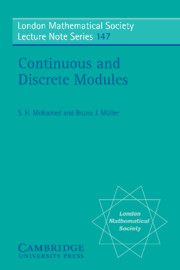Chapter 2 - Quasi–Continuous Modules
Published online by Cambridge University Press: 06 January 2010
Summary
In this chapter we discuss generalizations of the notion of continuous rings studied by von Neumann [36] and Utumi [65] to modules. Such modules are also generalizations of (quasi–) injective modules.
BASIC PROPERTIES
Proposition 2.1. Any (quasi–)injective module M satisfies the following two conditions: (C1). Every submodule of M is essential in a summand of M; (C2) If a submodule A of M is isomorphic to a summand of M, then A is a summand of M.
PROOF. Let N ≤ M and write E(M) = E1 ⊕ E2 where E1 = E(N). The quasi-injectivity of M implies, by Corollary 1.14, that M = M ∩ E1 ⊕ M ∩ E2; and it is clear that N ≤ e M ∩ E1. Hence (C1) holds.
Let M′ M be a monomorphism with M′ c⊕ M. Since M is M–injective, M′ is M–injective by Proposition 1.6. Then f splits by Lemma 1.2; thus (C2) holds.
Proposition 2.2. If a module M has (C2), then it satisfies the following condition: (C3) If M1and M2are summands of M such that M1 ∩ M2 = 0, then M1 ⊕ M2is a summand of M.
PROOF. Write M = M1 ⊕ M1* and let π denote the projection M1* ⊕ M1 →> M*1. Then M1 ⊕ M2 = M1 ⊕ πM2. Since π|M2 is a monomorphism, we get πM2 C⊕ M by (C2). As πM2 ≤ M11, M1 ⊕ πM2 C⊕ M.
Definition 2.3. A module M is called continuous if it has (C1) and (C2); M is called quasi–continuous if it has (C1) and (C3)
- Type
- Chapter
- Information
- Continuous and Discrete Modules , pp. 18 - 38Publisher: Cambridge University PressPrint publication year: 1990



